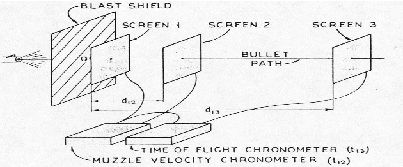This method, illustrated in Figure 2.3-2, uses two chronometers (time measuring instruments), which measure the time of flight t12 between screen 1 and screen 2, and the time of flight t13 between screen 1 and screen 3 for each round fired. The screen separation distances d12 and d13 are measured precisely and very accurately, and these distances remain the same for all rounds tested. Screens 1 and 2 are located close to the muzzle of the gun and are separated by at least 10 feet. These screens then provide an accurate measurement of the initial velocity of each round, which is obtained by dividing separation distance d12 by time of flight t12 for each round. This initial velocity is valid at a point halfway between screens 1 and 2, and this point is then the reference point for computations performed by Infinity. As in the previous method, a blast shield with a small hole for bullet passage usually is used to protect screens 1 and 2 from muzzle blast, muzzle flash and powder gases exiting the muzzle.

Figure 2.3-2 Test Range Setup for Initial Velocity and Time of Flight Method for BC Measurement
For each round fired the recorded measurements are the times of flight t12 and t13. Because the reference point for the trajectory calculations to be performed in Infinity is halfway between screens 1 and 2, corrections must be applied to the range distance and the bullet time of flight for each round. The corrected range distance for all trajectory calculations is the distance d13 minus half the distance d12; that is, the distance from the center point between screens 1 and 2 to screen 3. The time of flight for the trajectory calculation for each round is the measured time t13 minus half the measured time t12; that is, the bullet time of flight from the center point between screens 1 and 2 to screen 3.
When the firing test data have been obtained, Infinity is initialized with the measured altitude, atmospheric conditions and the corrected range distance for all rounds. Then, for each round fired, an iterative search for the correct BC value takes place in the same manner explained in the previous method (Section 2.3.1.1). In each iteration a BC value is guessed, a trajectory is calculated using the measured initial velocity out to the corrected range distance, and the calculated time of flight is inspected. The correct value of BC has been found for the test round when the calculated time of flight matches the corrected measured time of flight as closely as possible.
The precautions and points for consideration described in Section 2.3.1.2 for the initial velocity and final velocity method also generally apply to the present method. There is one significant difference. There is one less systematic error source in the initial velocity and time of flight method. There is no final velocity chronograph in this method, so the very sensitive systematic error source associated with measuring the screen separation distance for the final velocity chronograph does not occur. However, any measurement error in the separation distance between screen 1 and screen 2 will cause a highly sensitive systematic error in the BC values. A measurement error in the distance between screen 1 and screen 3 will cause a less sensitive systematic error in the BC values determined by this method. Any digital instrument that measures the travel times between the screens should contribute little or no errors in the measured BC values, because elapsed times can be measured very precisely and accurately.
